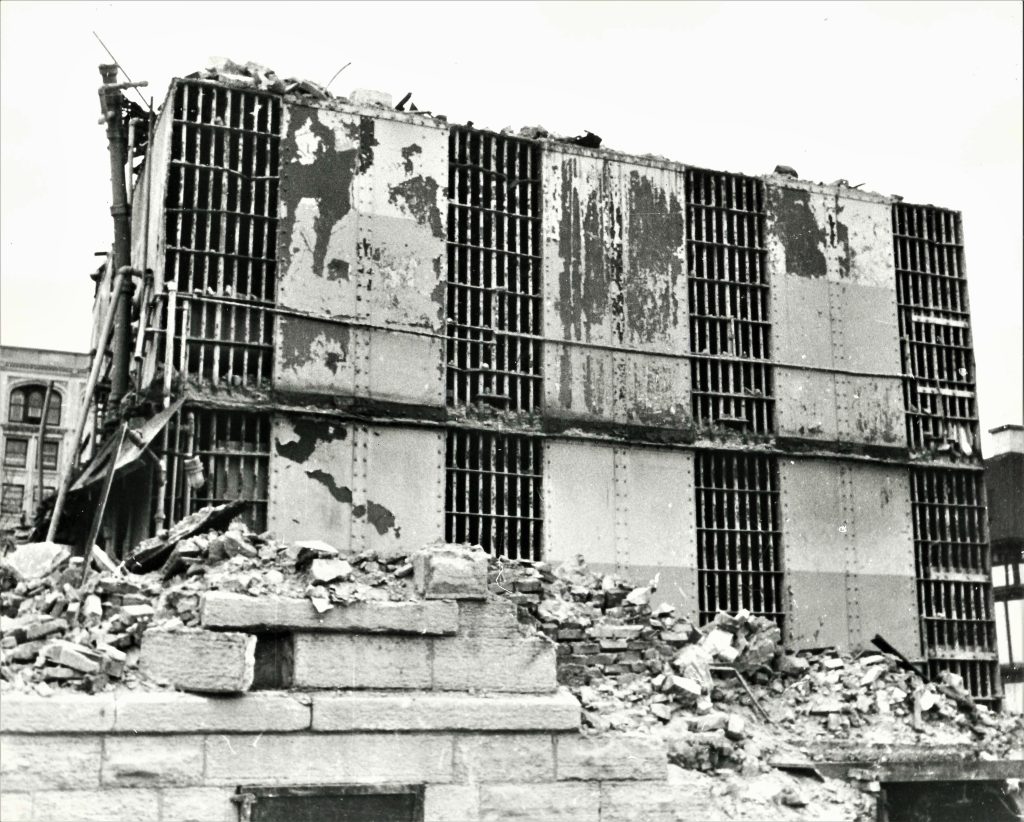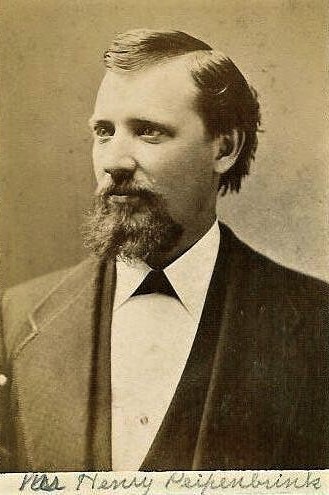Living and dying at the county jail


Henry Piepenbrink, sheriff at the time the new Will County jail was built.
By Sandy Vasko
Last time we met, we looked at the earliest county jail. Let’s go back there to see what happened next. The time is June of 1879.
Conditions at the county jail had become almost intolerable. The Will County Board created a committee to look into conditions in both the jail and court house. We read: “Henry Spangler, S. G. Nelson and M. A. Flack, committee from the county board on public grounds and buildings, have been doing good work in our city. The county jail, through its defective sewer pipes, had fallen into a sad, an almost intolerable condition. The committee made an investigation and then took matters of reform vigorously in hand. New pipes have been laid, old one opened, new floors constructed and a general renovation effected. The change in the atmosphere is loudly perceptible and pleasing.”
By 1883, conditions had once again deteriorated. Finally, it was decided to just build a new jail. “The new bridewell is being rapidly constructed in the rear part of police headquarters. Eight cells are being put in on one side, and there is room for eight more on the other side, whenever occasion requires their construction. The cells are being built of the best solid oak, and will be much more comfortable than those in the old bridewell.
“Bridewell keeper Broderick will live in the second story which will be pleasant and commodious quarters for him. The old bridewell will be utilized as a store house and as an impounding place for stray animals.”
In 1884, for as yet an unknown reason, the courts postponed all criminal cases. Those awaiting their day in court were dismayed and upset. “We found the men in a rather despondent frame of mind over the intelligence that had been communicated to them.
“Mr. and Mrs. Skinner and Mrs. Hungerford are upon the sick list. They, with Mr. Hungerford, are confined in one of the upper rooms, and Mr. Hungerford is employed as waiter and washman. Mrs. Hungerford imagined herself able to attend to such household arrangements as were necessary to keep the room in which they are confined in proper shape, and left her bed sooner than she ought to have done, and a relapse has followed.
“Phillip Feil, who was confined in the debtor’s cell, and took his imprisonment so much to heart at first, has been transferred to the cell room with other prisoners, his friends having failed to bail him out as he expected. He seems to have outgrown his disposition to so bitterly lament his situation and has resolved to make the best he can out of a bad lot of circumstances.
“Altogether there are 21 in jail waiting for trial, 19 of whom are males and two females. Two of this number have pleaded to their indictments and responded, not guilty. The remainder will be taken into Court next Monday morning to make their pleadings, when some of them will probably plead guilty with the view of having their punishment lessened.”
In January of 1894, the first hanging was held at the new jail. “Ernest LaCore, murderer of Ellen Byron, paid the penalty for his terrible crime the morning of Jan. 10 in the county jail yard, his soul being launched into eternity at 10:33 o’clock. LaCore’s neck was broken by the fall and death came quickly, in ten minutes the attending physicians announcing that all pulsations had ceased. The execution was in every respect a success.
“About 200 people witnessed the execution, the rough enclosure being filled. The door on the east side was opened to those holding passes about 9:30 o’clock, and the space within was rapidly filled. The spectators spent the time previous to the death march in smoking, talking and laughing, the scene presented being anything but the solemn one that might be expected.
“Among the spectators was a short, thick set young man with sad face and weeping eyes. He was Delosa LaCore, the prisoner’s older brother, and when his identity became known his presence was the subject of much curiosity and comment on the part of those in his vicinity. A pathetic incident was when he sang out ‘good-by brother,’ to the victim just before the drop fell and receive an answering ‘good-by’ in a firm voice.
“At the foot of the stone steps leading from the south jail entrance and just beneath the rough wooden steps leading to the scaffold, stood a coffin, partly covered by a blanket. It was where the prisoner’s glance could rest upon it as he mounted the steps, but whether he noted the appearance or not will never be known. In another corner beneath the platform stood the bag of sand with which the rope was tested.
“On the trap stood a chair and just in the rear an upright wooden box had been erected. This was to conceal the man who cut the rope releasing the trap. The name of this individual could not be learned from the Sheriff or his deputies, the desire being to keep it secret. It was whispered around, however, that Peter Spangler of Plainfield was the man.”
At 10:30 o’clock Sheriff Hennebry stepped from the jail entrance and addressing the audience said: “Gentlemen, do your smoking very quickly. There will be no more smoking allowed after five minutes. Now, I am not feeling in this matter,” he added, with a positive shake of the head, “What I say I mean. I want everybody to quit smoking.
“At 10:17 the basement door opened and up the steps came Deputy Haughton, leading the way for the doctors and jury, who are required by law to be present at every execution. The physicians were Messrs. Dougall and Swisher, and the jury was composed of the following twelve men: M. A. Flick, Joliet; Fred Wilke, Washington; Geo Adams, Peotone; J. J. Smillie, Custer; N. Engels, Wilmington; Jos. Kain, Braidwood; Elias Brown, Jackson; C. P. Boleken, Will; Thos. Langdon, Troy; John Francis, New Lenox; Robert Alexander, Joliet.
“Sheriff Hennebry drew a white hood over the prisoner’s face and his eyes were forever closed from this world. There was momentary pause. Sheriff Hennebry stepped silently back, gave the signal, a rattle was heard in the box at the rear and at 10:33 the trap gave way and the form of Ernest LaCore shot downward to death.
“The victim’s neck was broken by the fall. This was evident at first glance, and Dr. Dougall at once said the neck was broken, and broken well. The body swung round several times, and was then steadied by Deputy Olehaus, while the physicians examined the pulse. He lost consciousness immediately after the fall, and after hanging five minutes the pulse beats were very irregular up to 1:43, when he was pronounced dead.”
